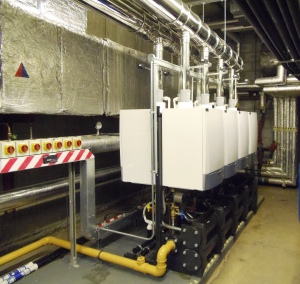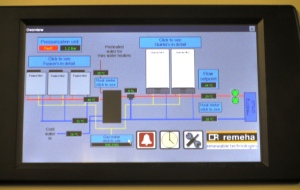The future of heating buildings

Improving the energy efficiency of our existing buildings is the greatest challenge facing the building-services industry. Smart system design can maximise the savings potential of today’s sophisticated heating technologies and bring us closer to achieving our steep environmental targets. James Porter of Remeha Commercial discusses.
Imagine the city of the future and the likelihood is that a sci-fi version of New York and its celebrated skyscrapers or of the City of London with its awe-inspiring futuristic architecture, will spring to mind. Yet, were it possible to fast forward to 2050 we would find our cities remarkably similar to those we see before us today. The fact is that 60% of the buildings that will stand in 2050 are already built and with us today, according to reports from the BRE and the Carbon Trust.
Therefore, while it is important that we legislate for greater sustainability in new building development, it is crucial that we address the energy efficiency of our existing buildings. With 40% of our buildings pre-dating 1985, the year that Part L of Building Regulations was first introduced for fuel and power, improving the performance of these older buildings is the main challenge facing the building-services industry today and critical if we are to meet our binding target of an 80% reduction in emissions by 2050.
 |
| Seven Remeha Quinta Pro boilers in cascade, upgraded controls and a new BMS have achieves £7000 in energy savings in heating the swimming pool of Aspire Leisure Centre at the Royal National Orthopaedic Hospital in Stanmore. |
Of all the services in buildings, heating is the greatest single user of energy — responsible for around half its total energy consumption and associated greenhouse-gas emissions. While new buildings are designed to use less heat, our existing buildings are some of the most inefficient in Europe, with many having old heating systems that require more energy to heat and produce higher than necessary bills.
Boilers supply the heating for around 80% of buildings in the UK, so replacing any inefficient or ageing models with a high efficiency boiler is invariably the most effective and affordable first step in raising a building’s thermal efficiency. Upgrading an atmospheric boiler that is 10 to 15 years old and operating at just 50% efficiency with a modern, fully-modulating, low NOx condensing boiler with headline efficiencies of 98% can transform the performance of a building — halving the energy use for heating and dramatically cutting emissions.
Whilst the savings potential of condensing boilers is huge, the widely reported performance gap between a building’s predicted energy consumption and its actual usage is not restricted to new buildings. In its report on reducing energy use in existing homes ‘Retrofit for the future: a guide to making retrofit work’, the Technology Strategy Board concluded that the total energy used post retrofit on most of the projects in the programme was at least 50% more than predicted, and as much as 100% greater for some. The same is true for non-domestic buildings, hence the need for smarter system design in order to maximise the savings from today’s high efficiency technology.
So how should we go about designing a heating system that will ensure optimum operation from individual components and the heating system as a whole? In a word, controls.
As we strive to reduce our carbon footprint, the typical boiler room of yesteryear has transformed into a multi-component plant room, often with the condensing boiler at the heart of a system that combines traditional and renewable technologies. Adding the appropriate advanced controls will optimise the performance of individual components and ensure good integration for improved overall performance.
 |
| Supporting two boilers for heating and hot water at a care home in Banbury are these gas-fired absorption heat pumps to supply most of the annual demand. |
For boilers, we recommend that the minimum control strategy should include valved zone control, thermostats and timers.
Further improvements can be achieved by 2-zone temperature and time control, weather compensation, and sequential control of boilers.
The next step is to add a building-management system to integrate the components fully within the system, enabling them to achieve higher efficiencies. Without an effective BMS control, the technologies may compete which could lead to underperformance and, ultimately, an energy performance gap. This is particularly relevant to hybrid systems that combine traditional and renewable technologies, so look for manufacturers who offer scalable BMS controls that fully integrate the new equipment into the existing system and can be tailored to match the requirements of the building.
Commissioning is often the stage that is rushed as projects run over time and budget, despite its valuable role in ensuring maximum thermal efficiencies. For a heating system to perform efficiently, reliably and effectively, it is essential to carry out thorough hydraulic, combustion and controls commissioning. Good commissioning is the difference between best performance and a performance gap between thermal modelling and actual energy consumption.
More in-depth knowledge and greater sharing of information are additional factors that will help the industry raise efficiencies. Using the same supplier or manufacturer on a project is beneficial due to their in-depth knowledge both of the products and of how best to combine them with other heating equipment to achieve the optimum results. Adopting a more collaborative approach within the product team also supports smarter system design.
 |
| BMS control of hybrid technologies such as boilers and heat pumps can prevent them competing and creating a performance gap. |
The government has attributed £840 million of savings on central public spend in 2013/14 to the increased uptake of Level 2 Building Information Modelling. Forward-thinking manufacturers now offer BIM objects of their products in the new standardised formats, promoting greater sharing of data for greater savings.
Manufacturers have risen to the challenge to develop ever-more sophisticated heating equipment that has the potential to hugely improve the performance of our existing buildings. The next step is to ensure that this potential is achieved through smarter system design.
James Porter is national sales manager with Remeha Commercial.







